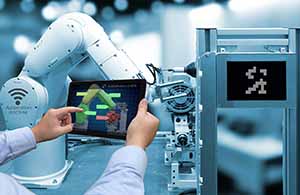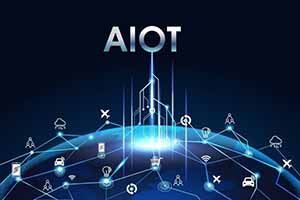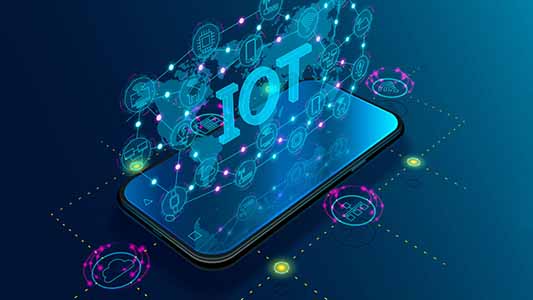Over the past few years, IoT has emerged as one of the most significant 21st-century technologies. The capacity of household devices as home appliances, autos, thermostats, and baby monitors—to connect to the internet via embedded devices has made continuous communication between people, processes, and things conceivable. The sharing and collection of data by physical things with the least amount of human involvement is made possible by low-cost computers, the cloud, big data, analytics, and mobile technologies. In the highly connected environment of today, digital technologies can record, monitor, and alter every contact between connected things. Even if the physical and digital worlds overlap, they coexist.
IoT in Industry

In the industrial sector, disruptive technologies are creating enormous waves by enabling enterprises to significantly improve their access to data to connect people, organisations, and technologies. Organizations can now easily access factory, production, and industrial equipment data from a distance thanks to these revolutionary technologies. The Industrial Internet of Things (IIoT), sometimes known as the Internet of Things, is the technology that has caused the most disruption in recent years. This is a network of intelligent devices with computer capabilities that are joined to systems for data collecting, monitoring, exchange, and analysis that are on an industrial level. Industrial applications like manufacturing, power plants, agriculture, oil, and gas are the primary emphasis of the IIoT. The term “Industrial Internet of Things” (IIoT) refers to a subset of the Internet of Things that is primarily focused on industrial applications. Smart devices are crucial to the IIoT because they improve communication of critical information and enable real-time data analysis and collection. Business choices can be made more efficiently and precisely using IIoT.
How IoT unlocking the Business Value

The application of IoT technology in industrial settings is particularly in terms of instrumentation and control of sensors and equipment that uses cloud-based technologies. Machine-to-machine (M2M) communication has recently been employed by several industries to accomplish wireless automation and control. With the rise of the cloud and related technologies (such as analytics and machine learning), industries can attain a new automation layer and with it new income and business models. The Industrial Revolution 4.0, often known as Industry 4.0, is another name for IIoT. Businesses are utilizing IoT’s enormous potential for business value as it becomes more commonplace in the marketplace. Worldwide businesses are staking a lot of money on the Industrial Internet of Things (IIoT), including its platforms, tools, and software. Investment in enterprise IoT increased by 21.5% to $201 billion in 2022. IoT Insights reduced the growth forecast for 2023 from 24% to 18.5%. The issue is how to convert investment into a profitable return. Several studies have shown that firms have trouble making a convincing business case for IoT because they are skeptical about the financial advantages. Thus, how can we quantify the ROI and how can we justify capital investment in the IoT becomes the crucial question for executives driving IoT efforts. The top worldwide motorcycle manufacturer Harley Davidson invests in a fully IIoT-enabled factory, linking important operations and equipment on a single network. The results were significant: downtime was decreased, manufacturing efficiency increased, and operating costs were cut by $200 million. The build-to-order cycle was also shortened by a factor of 36, and total profitability increased by 3% to 4%. Businesses will be in a better position to develop a business case if we have a clear vision and strategy to show strong leadership, concentrates thought, and fosters a sense of urgency.
IoT Needs Design, Not Just Technology

According to Gartner Research by 2022, the average family house was expected to have more than 500 networked gadgets. By the same year, Ericsson predicts 50 billion connected “things.” But in order to produce effective “connected” personal devices and home appliance items over the next four years, product designers and engineers will need to fundamentally rethink how they collaborate. Many businesses won’t struggle to make the transition to “Internet of Things (IoT) 2.0,” but rather because they won’t understand the importance of design in the creation of linked products. The predecessor of the consumer-focused IoT, machine-to-machine (M2M) connection, has been around for decades. User experience will increasingly influence market demand, and product design will play a crucial role in encouraging customers to accept offers in this new IoT 4.0 era. Companies may immediately improve current operations for supply chains, customer service, human resources, and financial services with cloud-based IoT apps. There is no need to start from scratch with every business procedure. An iPhone, a networking application, or wearable devices are a few examples of IoT. IoT is not bought by consumers. In actuality, research shows that most consumers are unaware of IoT or its potential. IoT connectivity can raise a product’s value, but it can never be the main factor in a customer decision to buy. The companies of an increasing number of product manufacturers are failing as a result of this misunderstanding of the IoT’s purpose. For example, Revolv, a hub for home automation that could connect to any light switch, garage door opener, home alarm, heating or cooling system, and entertainment system, is one famous example of this kind of IoT failure. Customers of Revolv were recently warned by the product’s maker, Nest, that their devices would no longer work. Nest is now owned by Google. Revolv is today regarded as a paradigmatic example of an Internet of Things product that was heavy on features and technology but short on meeting client needs. This type of “tech push” happens when management and engineering undervalue the importance of great design in capturing the end user’s physical and emotional connections. In comparison to the anticipated or actual user experience, product function is evaluated more highly.
Sustainable Designing in IoT

Every new product development is focused on addressing a challenge or grabbing an opportunity, but these challenges—obsolescence, profitability, and quality—often conflict with what consumers’ desire. In problem statements, the value to the customer should be considered, and this includes responding to simple questions. For an IoT solution, the lead systems person on the development team must also be aware about users and their experiences. This is true for any organization, where the lead systems person is likely to be familiar with the technological stack. Work with designers who are tech-savvy. IoT necessitates a tech-savvy design approach. The product experience now includes upgrades, interaction with other products, personalization, and big data.
Getting Started With AIoT

The IoT is the body, collecting and sending data from multiple sources, and AI is the brain, turning that data into the useful insights that drive an organization’s decision-making. Together, they comprise the AIoT, which is the body and brain of digital transformation. To start seeing value from AI, you don’t have to integrate it into every business process and function right now; instead, focus on a few carefully chosen industrial use cases, such predictive maintenance, automatic corrective actions, etc. Instead than imposing it all at once, this evolutionary strategy enables corporate executives and workers on the ground to start a more gradual transition into AI-driven ways of working. Contrary to popular belief, obtaining value from data science does not require specialized knowledge or skills; rather, it ensures a lower barrier to entry for AI adoption across the enterprise.
Conclusion
The advantages of IoT are strong, and numerous, well-established use cases demonstrate the substantial value that businesses across industries can provide. Yet, more than just a thorough understanding of the technology will be needed to discover the sweet spot for the IIoT. The proper mix of committed leaders, a clear focus on high-value use cases, and a cogent IIoT strategy and vision are all requirements for businesses. Businesses that are successful in these areas are providing important benefits and gaining a competitive edge that other business—those who find it difficult to move beyond experimentation—will find harder and harder to match. When end users don’t connect with an IoT product, technology is both the problem and the solution: “We require tighter security,” “Some other things need to work with us in a certain way.” “A mobile app is necessary,” Yet because the viewpoint of the customer is rarely included in the “we,” market acceptance falls until management decides to stop producing the item. Effective product design and innovation results from a purposeful, comprehensive strategy that places a high priority on producing goods that make people’s lives easier, more enjoyable, or more fulfilling, because to its inherent technical integration and innovative client experiences.












